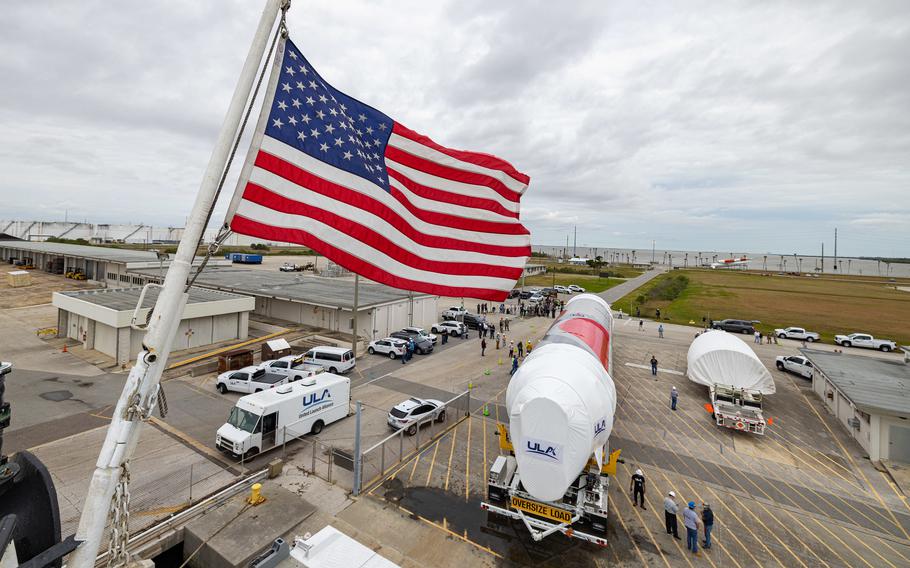
All elements of the first Vulcan rocket have arrived at Cape Canaveral in Florida (United Launch Alliance/Facebook)
(Tribune News Service) — The Space Coast has another new rocket in town as the United Launch Alliance Vulcan Centaur arrived by ship over the weekend ahead of its first launch this year.
The replacement for ULA’s Atlas V and Delta IV rockets still has testing to endure at Cape Canaveral Space Force Station, as well as the integration of its payloads, but the hardware separated into three massive parts was offloaded from the company’s RocketShip transport on Sunday. It arrived to Port Canaveral the day before after traveling more than 2,000 miles by river and ocean rom ULA’s factory in Decatur, Alabama.
Its arrival marks the fourth new orbital-class rocket to call the Space Coast home in just over a year joining NASA’s Space Launch System that took off from Kennedy Space Center for the first time last November on the Artemis I mission, small rocket provider Astra Space’s Rocket 3.3, which had two launches from Cape Canaveral, and Relativity Space’s Terran-1, a 3D-printed rocket awaiting its first-ever launch early this year from Canaveral as well.
Vulcan’s first launch is dubbed Certificaiton-1, slated to carry commercial company Astrobotic’s Peregrine lander to the moon, and the first two test satellites for Amazon’s Project Kuiper internet constellation. Also flying will be another human remains payload for Celestis Inc., this time brining the ashes of more than 150 people to space including “Star Trek” creator Gene Roddenberry and actor James Doohan who played “Scotty” on the TV series.
The Vulcan Centaur has been in the works since 2014, and only installed the last part of the puzzle — its new BE-4 engines built by Blue Origin — late last year. The engines are the one major part of the rocket that has yet to be flight proven as ULA has been testing out other aspects of the rocket by incorporating them into existing Atlas flights.
The American-made engines were key to satisfying congressional requirements to steer away from Russian-made engines by 2022, such as the RD-180s on the first stage that power Atlas V rockets. The BE-4s will also power Blue Origin’s own heavy lift rocket New Glenn.
The second stage of both Atlas V and Vulcan Centaur remain the Aerojet Rocketdyne RL-10 engine, which is manufactured in West Palm Beach. Northrop Grumman continues to provide the U.S.-made side boosters for ULA launches as well.
ULA has big plans for its new rocket including three Department of Defense missions this fall. It’s also on tap to send up the first-ever flight of Sierra Space’s new Dream Chaser spacecraft looking for certification to join SpaceX and Northrop Grumman as one of the three companies to resupply the International Space Station with launches from the U.S.
Vulcan already has more than 70 launches booked, the majority tied to Amazon’s Project Kuiper, which is looking to compete with SpaceX’s Starlink service.
The target launch date for Certification-1 is still before the end of March. Launches will be from Canaveral’s Space Launch Complex 41.
While Vulcan finds its space legs, ULA will keep flying Atlas V rockets for years, with enough built to support the Commercial Crew Program using Boeing’s CST-100 Starliner. The first crewed test flight of Starliner is slated to fly as early as April with regular rotational missions to be juggled with SpaceX Crew Dragon beginning in 2024.
Amazon also bought up all available Atlas V flights for Project Kuiper.
ULA also has two remaining Delta IV Heavy rockets with one set to fly in 2023 and the final one in 2024.
©2023 Orlando Sentinel.
Visit orlandosentinel.com.
Distributed by Tribune Content Agency, LLC.